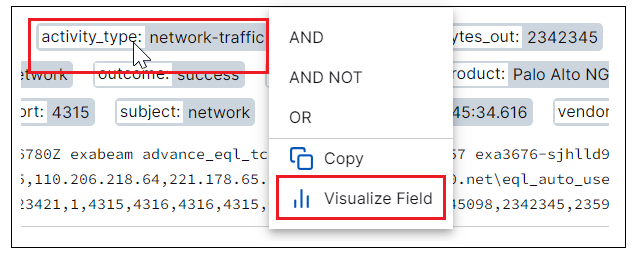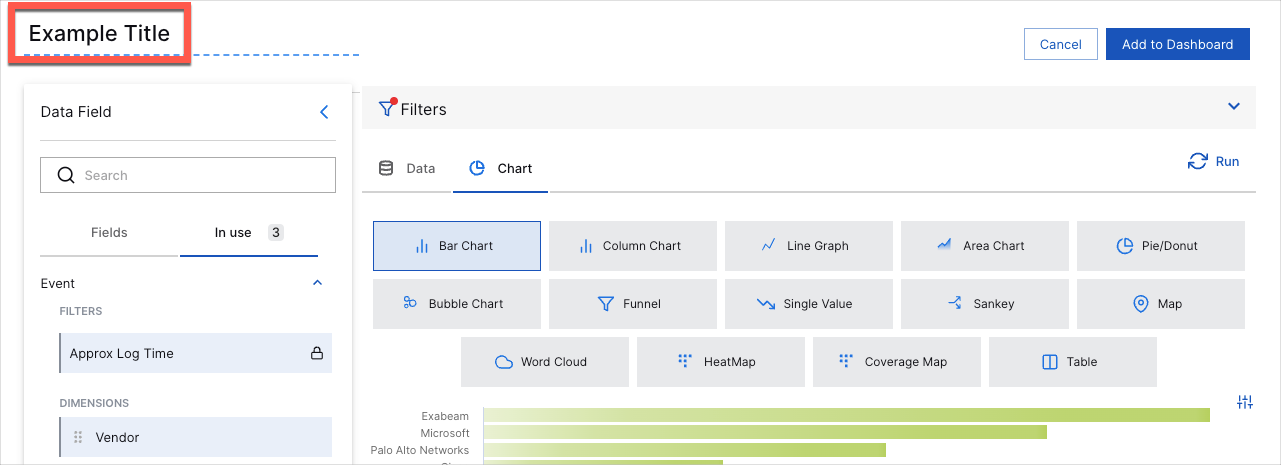- Dashboards
- Navigation Overview
- View and Interact with Dashboards
- View and Interact with Visualizations
- User Management
- Configure and Manage Dashboards
- Create a Dashboard
- Add a Visualization to a Dashboard
- Add a Text Tile
- Modify a Dashboard Layout
- Add Dashboard Filters
- Manage Automatic Refresh Rates
- Create a Scheduled Report
- Make a Dashboard Public
- Export and Import Dashboards
- Edit Dashboard Filters
- Edit Dashboard Details
- Duplicate a Dashboard
- Delete a Dashboard
- Configure and Manage Visualizations
- Create a Visualization
- Auto-Create a Visualization from a Natural Language Prompt
- Create a Visualization from a Search Query
- Add Visualizations from the Library to a Dashboard
- Modify a Visualization
- Configure Visualization Query Filters
- Include Context Filtering in Visualizations
- Make a Visualization Public
- Export and Import Visualizations
- Duplicate a Visualization
- Remove a Visualization from a Dashboard
- Delete Visualizations from the Library
- Configure and Manage Scheduled Reports
- Pre-Built Dashboards
- Advanced Analytics Dashboards
- AI/LLM Dashboards
- Case Manager Dashboards
- Compliance Dashboards
- Correlation Rules Dashboards
- Event Store Dashboards
- Access Grant and Revoke Activity
- Account Logout Summary
- Account Management Activity
- Application Security Event Summary
- Authenticated User Accounts on Hosts
- AWS CloudTrail Summary
- Data Loss Prevention Activity – Host-Based
- Data Loss Prevention Activity – User-Based
- Data Loss Prevention Activity Summary
- Default Account Access
- Default Credential Usage and Change Activity
- Denied Web Access Activity
- Disabled User Account Summary
- Discovered Attacks by Source and Destination
- Endpoint Detection and Response
- Failed Application Logon Activity
- Failed Audit Logs Summary
- Failed Host Login Attempt Counts by Users
- Failed VPN Login Attempts and Remote Session Timeouts
- Firewall Activity
- Firewall and Router Device Interfaces
- Insecure Authentication Attempts
- IOC Statistics
- Log Delay Insights
- Microsoft 365 Summary
- Microsoft Windows Overview
- Network Applications by Traffic Volume
- Policy Activity Summary
- Ports Usage Trend
- Privileged Access
- Privileged Access – User-Based
- Project Collateral
- Protocols by Network Traffic
- Remote Session Overview
- Security Alert Summary – Impacted Hosts
- Security Alert Summary – Origin Hosts
- Security Alert Summary – Users
- Successful Application Logon Activity
- Successful Database Login Activity
- Successful Physical Access
- Top Attackers
- User Account Creation Summary
- User Account Lockout Activity
- Vendor Authentication Activity
- Windows Audit Failure Summary by Hosts
- Windows Audit Failure Summary by Users
- Windows User Privilege Elevation
- Zscaler HTTP Dashboard
- Security Operations Center Management Dashboards
- Threat Center Dashboards
- Pre-Built Visualizations
- Anomalies - Use Case & MITRE Coverage
- Anomalies by Rule Name
- Anomalies by Use Case
- Anomalies Count Over Time
- Anomaly Distribution by MITRE Tactic & Score
- Application Count
- Closed Incidents
- Correlation Rules by Severity
- Correlation Rules Triggered Over Time
- Detected Anomalies
- Host-Based DLP Alerts Count
- Incidents Created
- Incident Summary by Incident Type
- Number of Hosts with DLP Alerts
- SOC Incident Distribution
- Top 5 Host-Based DLP Alert Categories
- Top 5 Protocols in Host-Based DLP Alerts
- Top 10 Host-Based DLP Alert Types
- Top 10 Hosts with DLP Alerts
- Top Activities per Top 10 Applications
- Top Users per Top 10 Applications
- Trend of Application Security Events
Create a Visualization from a Search Query
Quickly turn your queries in the Exabeam Search application into visualizations in new or existing dashboards. The filters in these visualizations are automatically configured to correspond with the same fields, operators, parameters, and timeframes as in your Search queries. You can also easily add an additional field to the visualization from the search results.
Note
By default, visualizations created from Search queries use the count measure. However, in the Dashboards application you can modify this property and others in the same way that you modify other visualizations.
To create a visualization from an Exabeam Search query:
In the Exabeam Search application, build a query and execute a search.
For more information, see Performing Searches in the Exabeam Search Guide.
When your search results are displayed, select a field and click the Visualize Field option. You can access the Visualize Field option from one of the following locations in your search results:
Event List – Click on a field and select Visualize Field.

Field Summary View – Click the field summary icon (). In the Field Summary list, click on a field to open the field details. Click Visualize Field.

Event Details – Click View all fields for a specific event. A panel opens and displays all the parsed fields. Hover over a field, click the options icon (
 ), and select Visualize Field.
), and select Visualize Field.
When you click Visualize Field, the new visualization opens in the edit mode of the Dashboards application.
When the new visualization opens for editing in the Dashboards application, enter a title for the visualization.

Click the Chart tab and then select an appropriate chart type for displaying the data.
Click Save. The new visualization is saved to the visualization library in Draft status. If you want to make the visualization available to other users or add it to a dashboard, navigate to the Visualizations home tab and see the following topics for more information:
Note
If you try to save the visualization but another visualization with the same name exists, you are prompted to change the name of the new visualization.
If you try to save a visualization but another visualization with the same definition exists (including dimensions, measures, filters, and chart type), you are prompted to change the definition of the new visualization or re-use the existing visualization.